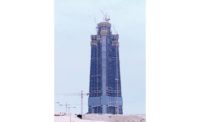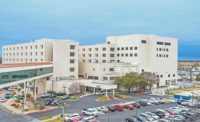What do you do when the entire scope of a project changes in a matter of months and you must stay on schedule to help meet the health care needs of a growing community?
That is the key challenge faced by the team designing and building a health-care campus in Utah’s Davis County.
In 2016, the same year that Intermountain Healthcare was named ENR Mountain States’ Intermountain Owner of the Year, the Utah-based nonprofit health care system said it intended to spend half-a-billion dollars a year over the next three to four years to boost its network of clinics and hospitals throughout the state.
The company has expanded, renovated and replaced several facilities or is in the process of doing so. And recently, it changed gears on a key project. Rather than simply building a surgical center and new medical office building (MOB) in Davis County, Intermountain Healthcare decided to build an entirely new hospital.
The $110-million project is now nearing completion on a 60-acre site in the Wasatch Front city of Layton, about 25 miles north of Salt Lake City.
“We had owned that land for some time, and originally we were looking at a medical office building and an out-patient surgical center,” says Corey Cracroft, senior project manager and architect for facility planning and development at Intermountain Healthcare.
“We had gotten through the design and development phase for that project, and then in June of 2015, the decision was made to build a hospital instead,” Cracroft adds.
Sarah Fitzgerald, communications manager for Intermountain Layton Hospital, says the change was made in response to growing community demands. “That area of Layton was really growing, and we were hearing more and more that people wanted an Intermountain hospital facility in Davis County,” she says.
While Intermountain Healthcare already has a large clinic north of the new hospital site, the closest hospital is McKay-Dee Hospital in Ogden, about 20 miles north.
The decision to build a hospital rather than a clinic meant scrambling to plan and redesign for a 180,000-sq-ft, full-service facility. The five-story structure would be attached to a four-story, 120,000-sq-ft medical office building and built adjacent to a central utility plant.
Back to the Drawing Board
The CM-GC contract for the project was issued to Jacobsen Construction of Salt Lake City. While construction of the office building and central plant got underway, the owner and lead design firm HKS Architects began the work of adding a hospital.
Roger Phillips, HKS project manager, says some of the basics, like how the building would be oriented on-site, already were established. “We knew we wanted it facing east to take advantage of the view of the mountains,” he says.
“We also knew (Intermountain) wanted to keep an ‘on-stage, off-stage’ separation between the public areas like the waiting and treatment areas in both the MOB and the hospital. We kept the imaging services like MRI and X-ray on the ground level and the surgical suites on the second level like they were in the plans for the surgical center, then we started expanding from there.”
Drew Watkins, project manager for Jacobsen Construction, says he and members of his team joined HKS for weekly meetings as the new design took shape.
“The CM-GC delivery method with Jacobsen meant they were involved before completion of the design,” says Cracroft. “When we were making changes, they were there to give input on different features and elements. It was a great benefit to have their help.”
Watkins says the construction contract eventually changed to a cost-plus, hybrid format shortly after the change in scope. “We would send out bid packages as the plans changed and worked with our subs to try and keep on schedule,” he says. “As the hospital design went on, all the engineering team—the structural, mechanical and electrical—were involved.”
Cracroft says the plan was to open the MOB and central plant first and the hospital later. Sitework began in April 2016.
Together But Separate
The substantially different engineering requirements for a full hospital required adjustments in site preparation, says Justin Nadauld, project manager for Salt Lake City-based structural engineering firm Reaveley Engineers + Associates.
Most of Davis County was once covered by a prehistoric lake, so the soil is generally silt and clay. “They expected excessive settlement from the loads we would be putting on that soil, so we ended up supporting the clinic and hospital foundations on rammed-aggregate columns,” says Nadauld. “Our column footings are built on top of the stone columns under the foundation.”
Watkins says due to the high water table in the area, crews had to create an extensive dewatering system around the foundation as well.
While the central plant, hospital and MOB foundations each needed reinforced soils, and the MOB and hospital are joined, they are structurally separate, says Mark Harris, principal-in-charge at Reaveley Engineers + Associates.
“The hospital had to be designed to a risk category four, which is the level required for emergency services buildings, hospitals and any place that would need to be functional after a major earthquake,” he says. “The medical office didn’t need to be built to that same level, so there is an expansion joint, a physical separation, between the two buildings.”
“The stairs became a prominent design element because you see them right when you walk in.”
– Roger Phillips, Project Manager, HKS Architects
Harris says different structural support systems were evaluated for the buildings, but with a large curtain wall on the east side of the hospital, cross-bracing with buckling-restrained braces was soon ruled out in favor of traditional moment frames.
“We needed to have stiffer joints for the moment frames, so we used a SidePlate design to get the stiffness we needed,” says Harris.
Other structural issues included supporting the walkways that cross the concave, curving five-story curtain wall on the east side of the hospital, Harris says. “There are places at either end that were tricky, where the curtain wall separates from the walkways.”
He says that the structure also was designed to accommodate a planned future expansion of the hospital and the office building.
Once complete, the hospital will include emergency services, four surgical suites, physical therapy, labor and delivery, special care nursery as well as outpatient services for Intermountain’s pediatric specialty hospital, Primary Children’s Hospital in Salt Lake City.
In addition to the abundant natural light from the glass curtain wall, Phillips says other sustainable features are intended to promote a “healing and healthy environment.” Rather than stairwells being hidden behind walls and doors, the hospital, as with other Intermountain projects, will feature “live-well stairs.”
“The stairs became a prominent design element because you see them right when you walk in,” says Phillips. “There’s lots of daylight on them and they are [located] by the elevators, but we’re trying to encourage people to take the stairs.”
Outside, a walking path circles the site. Plants and benches were designed to be comfortable spaces for both patients and visitors, Phillips says.
The MOB portion of the hospital campus opened to the public in September, and the hospital itself is slated for completion in August.








Post a comment to this article
Report Abusive Comment